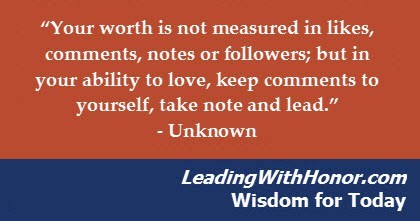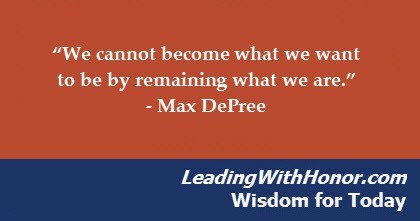Lee Ellis's Blog, page 303
June 27, 2015
Healthcare Physicians and Administrators Hear About Courageous Leadership – See Inside
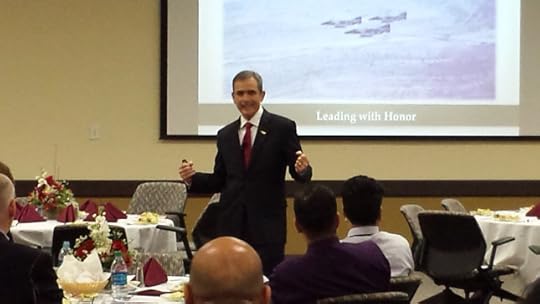
Lee Ellis speaks with physicians and administrators at the Gwinnett Medical Hospital System.
Recently, Lee was the keynote presenter for physicians (79% of the audience) and healthcare administrators (21% of the audience) at Gwinnett Medical Center, a large healthcare institution in the Atlanta metro area. We’re so grateful for the following results from their post-event survey –
1. Will you be able to use the information that you received today to improve patient care? Yes = 92.8%, No = 7.2%
Individual Takeaways: Positive attitude, Be better leader, To better my residency, Maintain values, Spread good emotions to patients and staff, Emotions are contagious, going to spread happiness.
2. Do you anticipate changing one or more aspects of your practice based on information at this conference? Yes = 67.3%, No = 32.7%
Individual Takeaways: Improve leadership skills, Be more courageous, More confidence, Better positive attitude at work, Work on values/mission.
3. Did this conference provide fair and balanced content? Yes = 98.3%, No = 1.7%
Link: Lee Ellis Keynote Presentations


June 26, 2015
Leading with Honor Wisdom for Today, June 26, 2015
“Your worth is not measured in likes, comments, notes or followers; but in your ability to love, keep comments to yourself, take note and lead.” – Unknown


June 25, 2015
Fantastic Article – “Discipline Breeds Success in Business and Leadership”
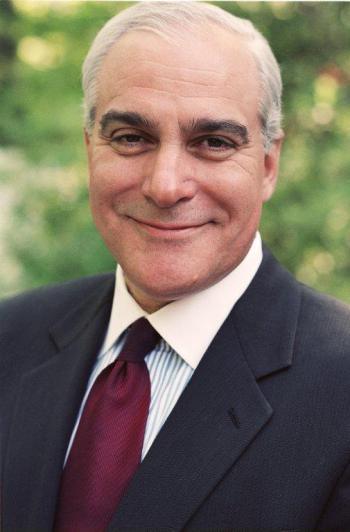
Author and Leadership Expert, Stuart L. Levine
Outcomes are not about luck. As Jim Collins says: “Greatness is a matter of choice, not circumstance.” In the language of emotional intelligence, the concept of discipline involves exercising self-regulation in order to improve.
It means consistently acting in alignment with your values, long-term goals and self-imposed performance standards, despite expedience or taking the easy path—an ability to remain steadfast in the face of herd instinct and external pressures.
Read more from this article by Stuart Levine, and be inspired –


June 24, 2015
Special Offer – Courageous Leader Development Package
Summer is the perfect time for personal leadership development. In just a few minutes everyday, you can learn more about your leadership strengths and struggles plus the leadership lessons that will guide your long-term success.
Learn more about the ‘Courageous Leadership Package’ below, and please share with others!
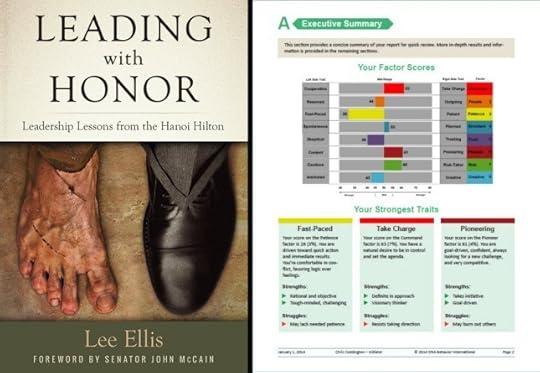
The Courageous Leader Package includes Lee’s award-winning book, Leading with Honor, and the Leadership Behavior DNA Assessment designed to pinpoint your natural leadership strengths and struggles. Click to learn more.


June 23, 2015
Fill in the Blank – “(Character or Competence) is the most important…”
Fill in the Blank – “(#Character or #Competence) is the most important #leadership attribute.”
Please share your answer.


June 22, 2015
Lee Shares Intimate Details about Guarding Your Character – See Inside
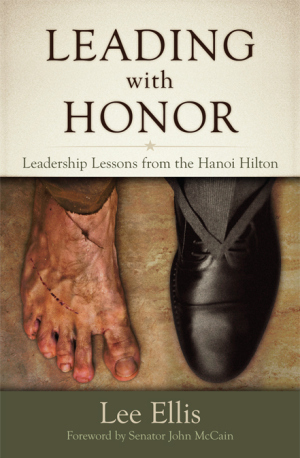
Click the book to learn more about Lee Ellis’ award-winning book, Leading with Honor.
In this Leading with Honor excerpt, Lee shares some very intimate points about the leadership principle of “Guarding Your Character” – please read and share –
“What causes one person to abandon his commitments even before he’s seriously tested, and another to keep his commitments nearly to the point of death? I’m quite certain both Fisher and Minter would say they were men of high integrity, but obviously they had vastly different views of what integrity means. One had real clarity about his values and a very strong commitment to keep them. The other was committed to his values as long as keeping them was convenient. When the going got tough, he found it easy to rationalize his way around his values by saying that war had never been declared.
Often people ask me why the Vietnamese so readily resorted to torture. My answer is that the communist system is founded on the belief that the end justifies the means. When they tortured half the guys in my camp to try to force them to sign public statements saying they had received “humane treatment,” they saw no disconnect, because their concept of truth was derived from their ideology, not the other way around. Their allegiance was to the party line, not to real truth. In fact, one of the interrogators told us that ‘truth is that which most benefits the party.’ A system based on such a significant flaw regarding integrity and honor can only survive on power and fear, reinforced by constant misinformation.
Unfortunately, this same ‘end-justifies-the-means’ mentality is becoming increasingly prevalent in our American culture. Business leaders are far too willing to cut corners to advance their organizations’ goals and their own careers. Greed is rampant on Wall Street. Politicians regularly make statements they know aren’t totally true and issue promises they don’t intend to keep. Confidence in the accuracy of media reporting is at an all-time low. To make matters worse, the rest of the citizenry are more and more inclined to excuse such behaviors as ‘the way things are done these days.’ We should expect our leaders and institutions to tell the truth, keep commitments, and consistently walk their talk. We must hold leaders accountable to lead with honor, and we should start with ourselves.”
(This article is an excerpt Chapter 2 of Leading with Honor: Leadership Lessons from the Hanoi Hilton.)


June 21, 2015
On This Day in Leadership History, June 21, 2015
On this day in leadership history in 2004, SpaceShipOne, designed by Burt Rutan and piloted by Mike Melvill, reached 328,491 feet above Earth in a 90 minute flight. The height is about 400 feet above the distance scientists consider to be the boundary of space.
Leaders—just when you think that a particular area of achievement has been completed, there is an opportunity to achieve more and further improve. Don’t be limited by past successes—keep achieving!
Space Ship One – Wikipedia


June 19, 2015
Leading with Honor Wisdom for Today, June 19, 2015
June 18, 2015
Discover Your Talents, Do What You Love – Lee’s Latest Interview
In this latest audio interview, Lee shares his insight into why it’s so important to do what you love in your work and career. Leaders who are working in their “sweet spot” are so much more equipped for long-term success.
Listen to this new interview, and please share your comments!


June 17, 2015
The Next Business Discipline: Applying Behavioral Economics to Drive Growth and Profitability
By Lee Ellis
Any business that’s intentional about growth tries to find the edge to get ahead of the competition. For years, Gallup has been researching how behavioral economics affects customers, employers, growth and profitability. The results of their research are filled with facts and implications that can revolutionize the way we do business. The following is a summary of their findings.
Introducing Behavioral Economics
For years business leaders have struggled to comprehend the apparent irrationality of employee and customer behavior and the impact it has on business performance. Fortunately, there is an emerging management discipline based on principles of behavioral economics that can help business leaders and executives make sense of the economic behavior of people and serve as a platform for effective management solutions.
Gallup research revealed that a study group of 10 companies that applied these principles outperformed peers by 85% in sales growth and more than 25% in gross margin during a recent one-year period.
For the past 30 years, behavioral economics has challenged the central premise of classical economic theory — that individuals will always behave rationally to achieve the best possible outcome. In fact, some have suggested that economic decision making is up to 70% emotional and 30% rational. Our emotional, cognitive, and perceptual processes place limits on how rationally we can view the world around us. These limits have a profound effect on the decisions we make — and subsequently on the way organizations need to think about how their employees and customers make decisions and ultimately behave.
Summary of Key Research Conclusions
Customer behavior is influenced more by emotion than reason, and these emotional dimensions can be measured and managed.
Employees have a tremendous impact on customers’ emotional engagement, for good or ill.
Employee behavior is influenced more by emotion than reason, and these emotional dimensions can be measured and managed.
The ability to engage employees depends on identifying the unique strengths they bring to their roles, selecting and positioning them for success by ensuring their strengths fit their roles, and providing them with an engaging workplace and an engaging manager.
The Top Line
Emotionally satisfied customers deliver significantly enhanced value to an organization by buying more products, spending more for those products, returning more often, and staying longer with the business. Customers who have a strong emotional connection to the organization represent an average 23% premium in terms of share of wallet, profitability, revenue, and relationship growth over the average customer.
In stark contrast, those customers whose emotional connection to the organization is weak or absent represent a 13% discount. At a local business unit level, those whose levels of customer engagement place them in the top 25% of comparable units within an organization tend to outperform all other units on measures of profit contribution, sales, and growth by a factor of two to one.
Clearly, engaging customers on an emotional level has a significant financial benefit.
Just as engaged customers are among an organization’s most profitable patrons and passionate advocates, engaged employees are an organization’s most productive and efficient workers. Teams of emotionally engaged employees deliver significantly better growth (productivity, profitability, and customer) and cost-reduction (turnover, absenteeism, theft, and safety) outcomes than disengaged work teams. Similarly, organizations that engage their employees grow their earnings more than 2½ times faster than organizations that do not.
Additionally, behavioral assessments like Leadership Behavior DNA further identify the natural behaviors of individuals to build more well-rounded internal teams to tackle this issue.
Unlocking Potential Profit
From a behavioral economics perspective, high performance organizations recognize the need to understand every individual’s unique set of characteristics, strengths, and weaknesses at the individual level, person by person, and to leverage it to drive performance. For new employees, this means deploying a disciplined selection process to match prospective employees’ strengths to the demands of their roles. For existing employees, a manager’s goal should be to use each person’s unique strengths for maximum effect, rather than trying to change the things that are difficult or even impossible to change. Employees whose supervisors focus on their strengths during performance reviews are more than 2½ times as likely to be engaged as those whose supervisors focus on their weaknesses.
The Bottom Line
Organizations that improve emotional engagement with employees and customers realize significant financial returns for their efforts. In fact, “optimized” teams within an organization — those that are in the top 50% of teams on both employee and customer engagement — generate a 240% boost in financial performance compared with teams that fail to engage their employees and their customers. As Figure 1 shows, optimized teams also significantly outperform those that scored high on one but not the other of these metrics.
Contrary to popular wisdom, our emotional traits are in fact quite predictable, and it is this long-ignored aspect of employee-customer relations that holds the key to superior performance and long-term growth.
LE
Would you like to assess and train your employees on understanding their natural behavior traits and how to relate to 10 unique customer types that they encounter everyday? Learn more about Leadership Behavior DNA Report and Training Services.
[1] Gallup Consulting. “The Next Discipline: Applying Behavioral Economics to Drive Growth and Profitability.” http://www.gallup.com/consulting/122906/next-discipline.aspx (2009). “CE11” and “Q12“ are Gallup Trademarks.



